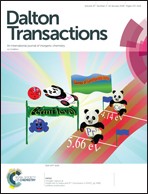Diversified polyoxovanadate derivatives obtained by copper(i)-catalysed azide–alkyne cycloaddition reaction: their synthesis and structural characterization†
Abstract
In this work, we confirmed that the copper-catalysed azide–alkyne cycloaddition (CuAAC) reaction is an effective method for the organic-functionalization of polyoxometalates (POMs). Herein, for the first time, four novel 1,2,3-triazole functionalized polyoxovanadate (POV) organic–inorganic hybrids, (Bu4N)2[V6O13{(OCH2)3C5H6N3O}2]·1.5CH3CN 2, (Bu4N)2[V6O13{(OCH2)3C7H8N3O2}2]·2CH3CN 3, (Bu4N)2[V6O13{(OCH2)3C11H10N3}2] 4 and (Bu4N)2[V6O13{(OCH2)3C10H7N3Cl}2] 5 were prepared through the CuAAC reaction using the azide functionalized hexavanadate, (Bu4N)2[V6O13{(OCH2)3CCH2N3}2]·2.5CH3CN 1, as the precursor, where CuI was used as the catalyst and N,N-diisopropylethylamine (DIPEA) as a stabilizer for CuI. All the four compounds were structurally and compositionally characterized by single-crystal X-ray diffraction, elemental analyses, powder X-ray diffraction (XRD), Fourier transform infrared (FT-IR), 1H NMR, ESI-MS, UV-Vis and thermogravimetric analysis (TGA).



 Please wait while we load your content...
Please wait while we load your content...